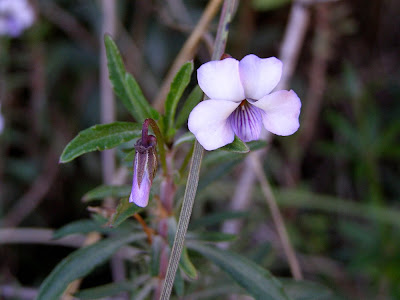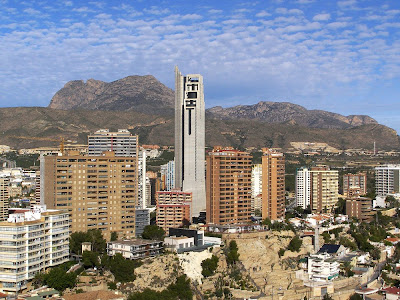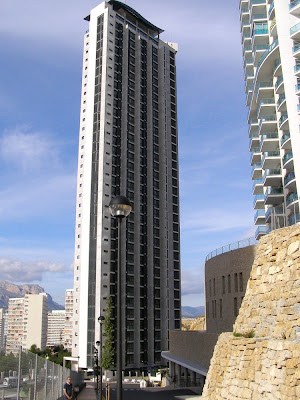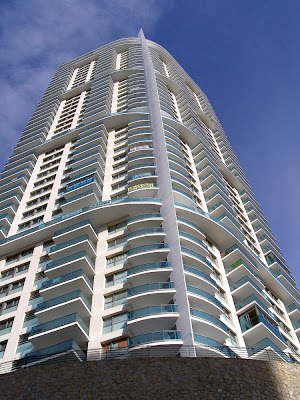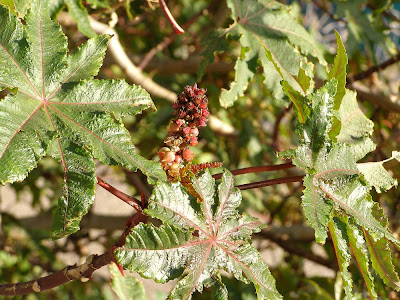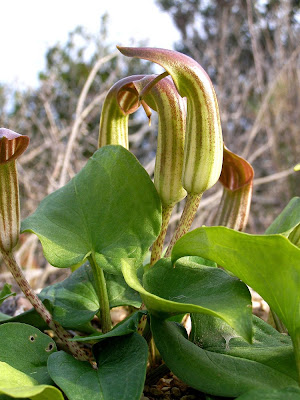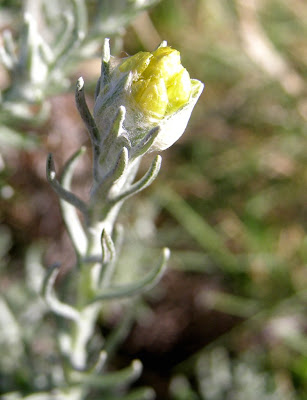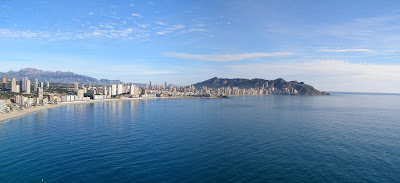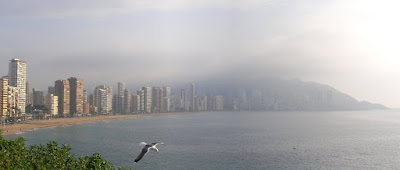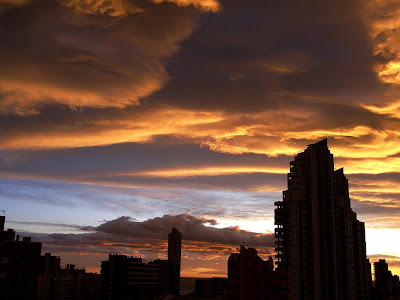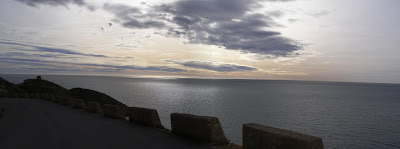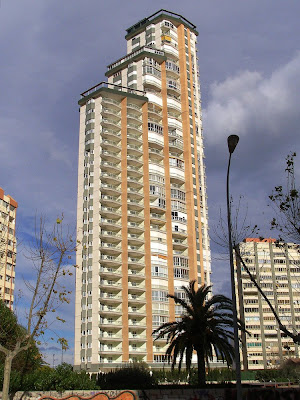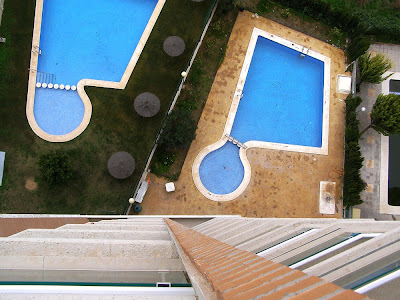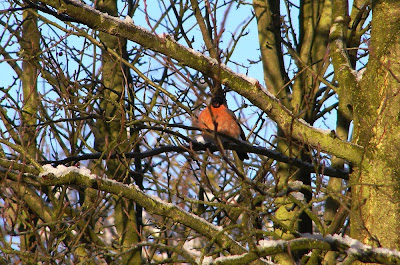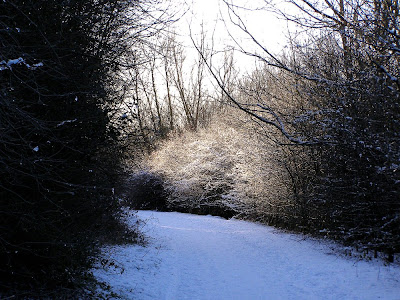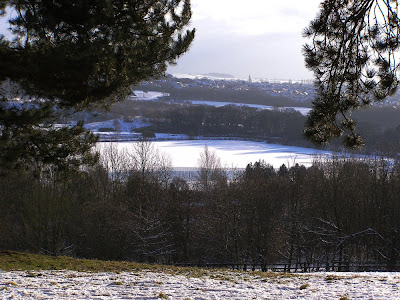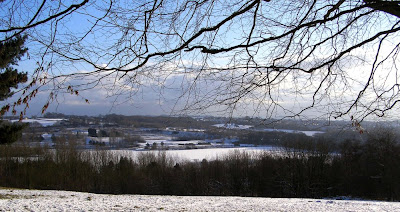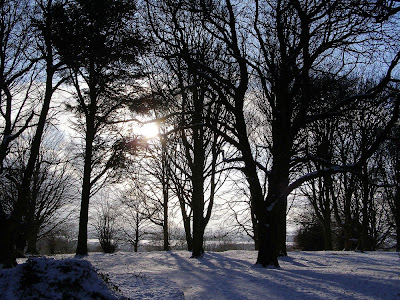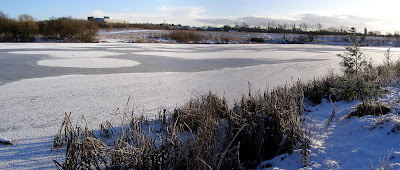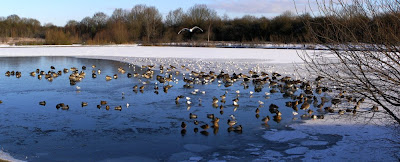A few more plant pictures today from our walks around Benidorm and the Sierra Gelada. The first was to be found growing on the cliffs of the Placa del Castell and is called White Henbane (Hyoscyamus albus). A highly poisonous plant as are all of the Henbane family, it has been used in antiquity as a psycho-stimulant in 'magic brews' to bring on hallucinations.
Secondly, a member of the pea family (there are so many of them). This one is called Rush-like Scorpion Vetch (Coronilla juncea) and is widely and commonly seen around the Mediterranean coasts. It makes a good show with it's golden flowers.
Thirdly, a plant well known to British gardeners as a summer bedding plant, but which grows in great abundance in the the Mediterranean area, Sweet Alison (Lobularia maritima). A diminutive member of the cabbage family, it almost carpets some places along the coast.
A new plant to me next and quite a little beauty. Small flowered and not easy to spot as it was growing among other plants, this is a blue-flowered Violet called Viola arborescens and is simply gorgeous close-up.
Lastly, a White Rock-rose (Helianthemum apenninum) which, again grows, seemingly everywhere around the dry, rocky slopes in these parts.
Welcome to my blog. Don't expect anything too high-tech or flashy, this is simply a 'diary' to share some of my photos, thoughts and observations - with a particular bias towards the natural world and the countryside around my home.
Sunday 31 January 2010
Saturday 30 January 2010
Plaça
There are two 'Plaças', in the old part of the town of Benidorm, standing next to each other and very popular with the locals and tourists alike. The Plaça de la Señoría is a wonderful, shady place to sit and enjoy the views out to sea while listening to the bells of the Church of St. James, surrounded by palms and Bird-of-Paradise plants and a statue dedicated to those souls lost at sea.
The larger of the two Plaças is the Plaças del Castell, which as the name suggests, is built on the remains of the old castle. Covered in gleaming, white tiles and dotted with trees and white doves, it is also a very popular place to sit and enjoy the sunshine.
The maritime tradition of Spain and Benidorm in particular, is picked up on with the placing of a very anchor on the square.
The church of St. James overlooks the whole scene with its famous blue-tiled domes and the need for a little 'touching up' on the white-washed walls. The inside of the church is superbly elaborate, colourful and typically Spanish catholic!
Almost nothing remains of the old castle - a few foundation stones are still there, propping up the modern square, but they are not at all obvious to the casual passer-by.
The larger of the two Plaças is the Plaças del Castell, which as the name suggests, is built on the remains of the old castle. Covered in gleaming, white tiles and dotted with trees and white doves, it is also a very popular place to sit and enjoy the sunshine.
The maritime tradition of Spain and Benidorm in particular, is picked up on with the placing of a very anchor on the square.
The church of St. James overlooks the whole scene with its famous blue-tiled domes and the need for a little 'touching up' on the white-washed walls. The inside of the church is superbly elaborate, colourful and typically Spanish catholic!
Almost nothing remains of the old castle - a few foundation stones are still there, propping up the modern square, but they are not at all obvious to the casual passer-by.
Friday 29 January 2010
Vertiginous
There are many tall buildings in Benidorm as I have mentioned before. The tallest of them all is the Gran Hotel Bali which stands some 610ft tall and was the tallest building in mainland Europe until the Hotel Ukraine was built in Moscow. It remains the tallest building in Spain. It has 52 floors above ground.
At the the other end of the resort, there stand two more tall buildings. The first of which is the Edificio Don Jorge. Standing some 407ft and 36 floors it is a residential block containing 165 apartments.
The building was completed in 2008 and stands next to another very tall building, the Torre Lugano.
The Lugano was also completed in 2008 and is the second tallest building in Benidorm at 518ft and 43 floors above ground and 5 underground for car parking. Although it is the second tallest building, it is actually the highest building in the town reaching 778ft above sea level, it's top at about the same height as the cross on the Sierra Gelada which overlooks the scene.
Sadly, a builder working on the construction, fell to his death from the 36th floor in 2006!
At the the other end of the resort, there stand two more tall buildings. The first of which is the Edificio Don Jorge. Standing some 407ft and 36 floors it is a residential block containing 165 apartments.
The Lugano was also completed in 2008 and is the second tallest building in Benidorm at 518ft and 43 floors above ground and 5 underground for car parking. Although it is the second tallest building, it is actually the highest building in the town reaching 778ft above sea level, it's top at about the same height as the cross on the Sierra Gelada which overlooks the scene.
Sadly, a builder working on the construction, fell to his death from the 36th floor in 2006!
Thursday 28 January 2010
Watch the birdy
The Sierra Gelada is a grand place to see wildlife of all kinds. Over the last few years we have seen all sorts, from Dandelions to Dolphins from our walks along the cliffs. Today, some wonderful birds from this year. Starting with a small and very wary bird called a Black Wheatear (Oenanthe leucura). Not found in Britain, this is a rather shy bird and so often difficult to photograph. Here, a pair of Black Wheatears are seen perched on a rock and showing their overall dark plumage, except for a bright, white flash on their rumps. They used to be classified as a member of the thrush family, but thinking has changed on this subject recently and they are now thought to belong to the family of Old World Flycatchers.
An extremely bad photo next and I make no apologies for that, for the bird I was trying to 'capture' is an exciting and very elusive little devil. The Blue Rock-Thrush (Monticola solitarius) is a member of the thrush family and as such, is related closely to our well-known Blackbirds and thrushes. Here, a male bird was doing it's best to avoid being photographed, but I managed to 'snap' him on full optical and digital zoom - which is why the picture is so grainy and bad. Despite this, you can still see the wonderful steely-blue colour, best seen in good light.
A better picture now, this time of a bird we have in Britain and an impressive bird it is too. The Raven (Corvus corax). The largest of the crow family, they make a spectacular sight as they display to each other as these two were doing. As part of the display, one of the Ravens could be seen flipping over onto it's back to fly upside down for a few moments while calling constantly with it's deep, guttural, throaty sounds.
The largest bird to finish with and another gorgeous specimen seen close to. The Yellow-Legged Gull (Larus michahellis) is like the Mediterranean version of the more familiar Herring Gull. Large and very noisy, they are well known for their 'laughing' calls which seem to echo all around the seaside. They always seem to be alert for food and their red-rimmed yellow eye is always searching for an opportunity.
An extremely bad photo next and I make no apologies for that, for the bird I was trying to 'capture' is an exciting and very elusive little devil. The Blue Rock-Thrush (Monticola solitarius) is a member of the thrush family and as such, is related closely to our well-known Blackbirds and thrushes. Here, a male bird was doing it's best to avoid being photographed, but I managed to 'snap' him on full optical and digital zoom - which is why the picture is so grainy and bad. Despite this, you can still see the wonderful steely-blue colour, best seen in good light.
A better picture now, this time of a bird we have in Britain and an impressive bird it is too. The Raven (Corvus corax). The largest of the crow family, they make a spectacular sight as they display to each other as these two were doing. As part of the display, one of the Ravens could be seen flipping over onto it's back to fly upside down for a few moments while calling constantly with it's deep, guttural, throaty sounds.
The largest bird to finish with and another gorgeous specimen seen close to. The Yellow-Legged Gull (Larus michahellis) is like the Mediterranean version of the more familiar Herring Gull. Large and very noisy, they are well known for their 'laughing' calls which seem to echo all around the seaside. They always seem to be alert for food and their red-rimmed yellow eye is always searching for an opportunity.
Wednesday 27 January 2010
Flower
Even though it is the middle of the winter, there are still some plants in flower around the Sierra Gelada. Here are just a few. Firstly a prickly little number known as Grey Asparagus (Asparagus horridus - also known as Asparagus stipularis). A close relative of the well-known and delicious vegetable, you wouldn't want to eat this spiky thing!
A medicinal plant next and one which you will have heard of. The Castor Oil Plant (Ricinus communis). Castor seed is the source of Castor Oil. The seeds contain up to 60% oil, rich in triglycerides, mainly ricinolein. The seed contains ricin, a toxin, which is also present in lower concentrations throughout the plant.
A member of the pea family now. A small-flowered and rather gorgeous plant called Coronilla minima. The name Coronilla means 'little crown' and refers to the crown-shaped arrangement of flowers on the ends of the stems.
A very common Mediterranean plant next, the Friar's Cowl (Arisarum vulgare). At just a few inches tall, these members of the Arum family of plants produce large patches of leaves and flowers during the winter months all over the place.
Lastly for today, an everlasting flower. We are all familiar with the papery, everlasting flowers found for sale in florists, well this is a smaller flowered relative of those. Helichrysum stoechas has small yellow flowers and grey, hairy leaves which hep conserve water in the hot summer weather. It also has a strong aroma of curry when the leaves are crushed, particularly when dried out.
A medicinal plant next and one which you will have heard of. The Castor Oil Plant (Ricinus communis). Castor seed is the source of Castor Oil. The seeds contain up to 60% oil, rich in triglycerides, mainly ricinolein. The seed contains ricin, a toxin, which is also present in lower concentrations throughout the plant.
A member of the pea family now. A small-flowered and rather gorgeous plant called Coronilla minima. The name Coronilla means 'little crown' and refers to the crown-shaped arrangement of flowers on the ends of the stems.
A very common Mediterranean plant next, the Friar's Cowl (Arisarum vulgare). At just a few inches tall, these members of the Arum family of plants produce large patches of leaves and flowers during the winter months all over the place.
Lastly for today, an everlasting flower. We are all familiar with the papery, everlasting flowers found for sale in florists, well this is a smaller flowered relative of those. Helichrysum stoechas has small yellow flowers and grey, hairy leaves which hep conserve water in the hot summer weather. It also has a strong aroma of curry when the leaves are crushed, particularly when dried out.
Tuesday 26 January 2010
Views
Some lovely views were, once again on offer as we took our daily walk around the environs of Benidorm.
One of the best views to be had of the whole town, is from one it's southernmost extremities, the small, rocky pinnacle of the Hermitage.
The view also includes the small range of hills known as the Sierra Gelada. Much the same view can be had from the site of the ancient Castle, now known as the Placa del Castell. On this particular occasion, the mist had descended over the Sierra - and a cheeky gull had crept in to the picture.
On a clearer day, it is possible to see well beyond the skyscrapers of the town and the Sierra Gelada, to the huge monolith of the rock of Calpe (remember this entry from last year, when we got up-close to the rock).
Another view of the town, a little closer to the action this time, is of the Parque L´Aigüera.
Last view for now, takes us up into the hills of the Sierra Gelada on our way to the large cross which overlooks the town. Beyond the town you get a good view of the mountains inland. The most famous of these is the 'chipped' mountain of Puig Campana which rises to approximately 4,626ft. In impressive sight, the name means 'Bell Mountain' - though you will not hear it ringing! The 'chip' is supposed to have ended up as the small island in the sea off Benidorm, known as Peacock Island.
One of the best views to be had of the whole town, is from one it's southernmost extremities, the small, rocky pinnacle of the Hermitage.
The view also includes the small range of hills known as the Sierra Gelada. Much the same view can be had from the site of the ancient Castle, now known as the Placa del Castell. On this particular occasion, the mist had descended over the Sierra - and a cheeky gull had crept in to the picture.
On a clearer day, it is possible to see well beyond the skyscrapers of the town and the Sierra Gelada, to the huge monolith of the rock of Calpe (remember this entry from last year, when we got up-close to the rock).
Another view of the town, a little closer to the action this time, is of the Parque L´Aigüera.
Last view for now, takes us up into the hills of the Sierra Gelada on our way to the large cross which overlooks the town. Beyond the town you get a good view of the mountains inland. The most famous of these is the 'chipped' mountain of Puig Campana which rises to approximately 4,626ft. In impressive sight, the name means 'Bell Mountain' - though you will not hear it ringing! The 'chip' is supposed to have ended up as the small island in the sea off Benidorm, known as Peacock Island.
Monday 25 January 2010
Sky
We were fortunate enough to have some wonderful weather in Benidorm. Having said that, it was a little drizzly the day we arrived, but as we spent the afternoon sorting out, unpacking and getting some shopping in, it didn't matter at all.
Some of the skies were breathtakingly colourful, as in this one taken from our balcony in the early evening.
A little later one evening and the sunset was fiery-red as the lights started to come on around the town.
If I managed to get out of bed early enough, the sunrises were pretty good too. As the sun rose over the Sierra Gelada - the range on hills to the east of the town - it burst through the morning mist in dazzling shafts.
Along the paths around the Sierra Gelada, on the way to the Castel del Mar, the skies over the sea were also colourful, although more subtle in their showiness.
Some of the skies were breathtakingly colourful, as in this one taken from our balcony in the early evening.
A little later one evening and the sunset was fiery-red as the lights started to come on around the town.
If I managed to get out of bed early enough, the sunrises were pretty good too. As the sun rose over the Sierra Gelada - the range on hills to the east of the town - it burst through the morning mist in dazzling shafts.
Along the paths around the Sierra Gelada, on the way to the Castel del Mar, the skies over the sea were also colourful, although more subtle in their showiness.
Sunday 24 January 2010
Return
Malcolm and I returned yesterday, from our annual, winter break in Benidorm. We stayed at the Playamar Apartments, situated in the 'Playa Azul' building, an imposing edifice in three parts.
Our apartment was on the thirteenth floor of the shorter, left-hand section of the building. We had a great view from about 100ft up but that is a small part of the total height of the building which reaches more than 350ft in total. The building was finished in 2002 and affords fine views of many of the other sky-scrapers of the Benidorm skyline.
Looking over the edge of our balcony, was a little vertigo inducing and you certainly wouldn't want to dive off into the pool from this height!
More pictures to come......
Our apartment was on the thirteenth floor of the shorter, left-hand section of the building. We had a great view from about 100ft up but that is a small part of the total height of the building which reaches more than 350ft in total. The building was finished in 2002 and affords fine views of many of the other sky-scrapers of the Benidorm skyline.
Looking over the edge of our balcony, was a little vertigo inducing and you certainly wouldn't want to dive off into the pool from this height!
More pictures to come......
Sunday 10 January 2010
Shovel It!
Trudging through the snow as we walked around the lakes this morning, we were surprised to see some 'foreigners' swimming around in the small sections of ice-free water. Three or four pairs of Shovelers (Anas clypeata) were 'shoveling' around the water in search of anything to eat.
Not a rare species of duck, but not usually easy to see as they are very shy birds, which is why these pictures are a little 'distant'.
Rather beautiful and colourful, the males stand out amid the other swimmers, the females however, are more drab and resemble female Mallards - until you get to the bill, which is enormous for the size of the bird, making it look very front-heavy.
It's wonderful to see these little beauties, but it shows how harsh the winter is as they have obviously been forced to move about in search of feeding sites. Nice that they chose our local lakes.
Not a rare species of duck, but not usually easy to see as they are very shy birds, which is why these pictures are a little 'distant'.
Rather beautiful and colourful, the males stand out amid the other swimmers, the females however, are more drab and resemble female Mallards - until you get to the bill, which is enormous for the size of the bird, making it look very front-heavy.
It's wonderful to see these little beauties, but it shows how harsh the winter is as they have obviously been forced to move about in search of feeding sites. Nice that they chose our local lakes.
Saturday 9 January 2010
More Snow
Snow has fallen, snow on snow.......... sing up, you all know the rest.
After another covering of snow last night, adding about an inch to what already lay, it was still snowing this morning as I made our first coffee of the day. We needed to go into town this morning, so no country walks for us today. Before leaving, we called Malcolm's mum to see what she needed bringing from Tesco, then set out, trudging through the 'deep and crisp and even'.
Yesterday, we were privileged to see a Bullfinch (Pyrrhula pyrrhula) in a tree. What a beautiful bird, very shy and so difficult to get close enough to photograph.
The sun was shining through the trees and illuminated small sections of the hedgerows as we walked. They shone wonderfully in the snowy gloom.
The reflected light from the branches was highlighted by the frost and snow which clung determinedly to them, sparkling in the sun like glitter.
Yesterday, we were privileged to see a Bullfinch (Pyrrhula pyrrhula) in a tree. What a beautiful bird, very shy and so difficult to get close enough to photograph.
The sun was shining through the trees and illuminated small sections of the hedgerows as we walked. They shone wonderfully in the snowy gloom.
The reflected light from the branches was highlighted by the frost and snow which clung determinedly to them, sparkling in the sun like glitter.
Friday 8 January 2010
Icy View
Another fine, sparklingly cold day, though not quite as cold as yesterday. Just -4C as we set out for a walk up Shipley Hill to get a view of the surrounding area and the snow covering.
We passed the lake of the old American Adventure theme park on our way. The ice was thick and almost covered the entire lake, except for a small corner which was being kept ice-free by the ducks, swans and gulls.
All was white as far as the eye could see, with more cloud than yesterday, promising more snow showers later.
Small patches of green were still visible beneath the old Beech trees on top of the hill. This particularly large, old specimen standing looking over the frozen scene - it has probably seen many more like it during it's lifetime.
Pale, Wintry sunshine struggled to penetrate the skeletal trees on the hill, illuminating the covering of snow on the ground. Stunningly beautiful, but time to head for home and get warm again.
We passed the lake of the old American Adventure theme park on our way. The ice was thick and almost covered the entire lake, except for a small corner which was being kept ice-free by the ducks, swans and gulls.
All was white as far as the eye could see, with more cloud than yesterday, promising more snow showers later.
Small patches of green were still visible beneath the old Beech trees on top of the hill. This particularly large, old specimen standing looking over the frozen scene - it has probably seen many more like it during it's lifetime.
Pale, Wintry sunshine struggled to penetrate the skeletal trees on the hill, illuminating the covering of snow on the ground. Stunningly beautiful, but time to head for home and get warm again.
Thursday 7 January 2010
Joy!
We awoke again this morning, to plunging temperatures, 'Gin-clear' skies and 'Champagne-cold'. The prospects of getting out into the snow for a walk after being kept in for so long, filled me with excitement - and filled Malcolm with icy dread!
We set out after breakfast with the thermometer still reading -6C but the freshly fallen snow making it much easier to walk in than the naked ice of previous days.
The sun shining through the trees and highlighting the sparkling frost and snow crystals, was breathtakingly beautiful.
Onward towards the 'DBC Bogwash' as mentioned (and pictured) before and the frigid scene which greeted us was amazing. Coots, Mallards, Swans and Gulls all having to share small, ice-free holes in the otherwise solid lake.
This scene was repeated further along the walk as we approached 'Straw's Bridge' pond. Here the Geese, Ducks and Gulls were sharing the limited available free water with more good grace than is usual.
Turning for home we passed another of the ponds. This one was completely frozen from shore to shore and a thick covering of snow on the ice revealing a multitude of footprints from birds and foxes. The sign next to the lake, seems a little redundant at the moment!
We set out after breakfast with the thermometer still reading -6C but the freshly fallen snow making it much easier to walk in than the naked ice of previous days.
The sun shining through the trees and highlighting the sparkling frost and snow crystals, was breathtakingly beautiful.
Onward towards the 'DBC Bogwash' as mentioned (and pictured) before and the frigid scene which greeted us was amazing. Coots, Mallards, Swans and Gulls all having to share small, ice-free holes in the otherwise solid lake.
This scene was repeated further along the walk as we approached 'Straw's Bridge' pond. Here the Geese, Ducks and Gulls were sharing the limited available free water with more good grace than is usual.
Turning for home we passed another of the ponds. This one was completely frozen from shore to shore and a thick covering of snow on the ice revealing a multitude of footprints from birds and foxes. The sign next to the lake, seems a little redundant at the moment!
As I started by mentioning the Gin-clear skies and Champagne-cold weather, it seemed fitting to end our walk with a warming (and purely medicinal) 'splosh' of Brandy in our coffee when we got back home........It soon brought the colour back to Malcolm's cheeks.
Subscribe to:
Posts (Atom)


